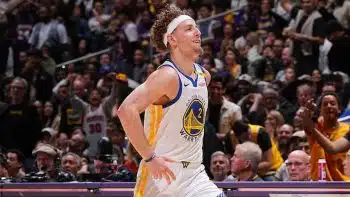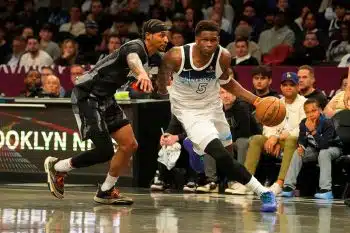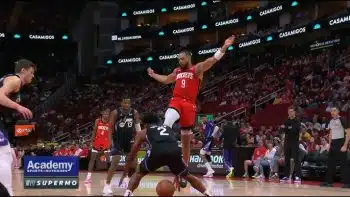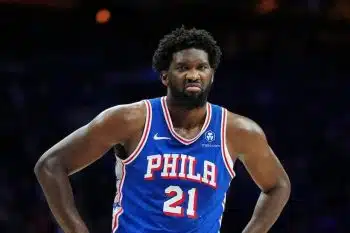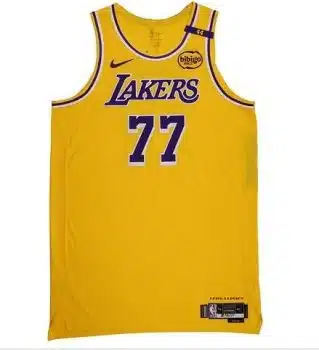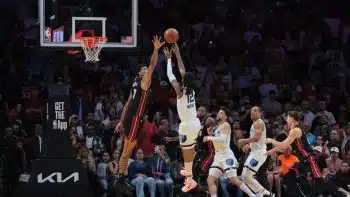NBA
NBA Study: What do you need to trade to get a star player in 2024?
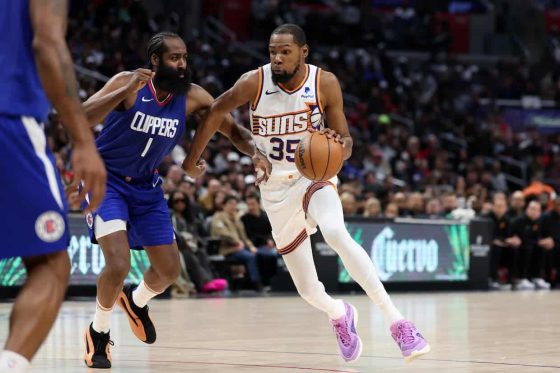
Key Highlights:
- To understand how much stars are worth on the open market, you need to look at trades for stars from the recent past
- You need to factor in things like length of contract, annual amount, player age, injury history, and caliber of star (All-Star, All-NBA, MVP, etc.)
- Since 2021-22, 12 “star” caliber players have been traded
No matter what level of NBA fan you are, everyone loves to talk about trades, especially when those trades involve the league’s best and brightest.
But do you know what people love doing even more than talking about star trades that have already happened? Obsessing over predicting future star trades that could happen in the future. It’s an odd fetish, I get it. Why speculate about what could happen in the future when we already have so much to enjoy in the present? I say this to myself every day. But it isn’t my job to analyze human nature. My job is to analyze basketball!
Anyway, thinking about future star trades is cool. But the best way to do it is by envisioning realistic scenarios. And to do that, we need to know how much star players are actually worth in the trade market. So, in this edition of NBA Study, we look at past star trades to try and figure out how much it costs to get an NBA star today.
Ground Rules
Before we get started, let’s set up some barriers for our analysis. First, for the sake of everyone’s time (and the cartilage in my fingers), we are only going to look at trades that occured between the start of the 2021-22 league year and now (in total, that’s 12 star players). It’s also better that we keep this study recent because the value of players has changed so much over the years. So, to avoid clouding our sample size, we’ll focus on the last three years.
Second, we are examining all these deals through the lens of the time they occured. Hindsight is 20/20, and I’m not going to make valuations based on circumstances that hardly anyone could have seen coming (i.e., Tyrese Haliburton becoming one of the best offensive players on the planet). If X player was viewed as a solid starter during the time the trade was made, that is what we are considering, regardless of what they ended up becoming after the fact.
Third, to keep this article semi-condensed, we are going to make generalizations about how valuable a certain player type is. For instance, we’ll say a solid starting caliber player is worth about one first round pick. Not all solid starting caliber players are created equal in terms of value. But to keep the word count down, we needed to oversimplify certain parts of this exercise.
And lastly, for the sake of this study, a star player is someone who had made an All-Star team in the last two seasons prior to the year they were traded. That eliminates someone like Kristaps Porzingis (although he is arguably looking like an All-Star this year).
Now, without further ado, let’s get into the trade discourse.
Domantas Sabonis (2021-22)
Player (Age at Time of Trade): Domantas Sabonis (25)
EPM Season of Trade (Rank): 2.8 (44)
Cost: Tyrese Haliburton, Buddy Hield, and Tristan Thompson.
Additional Context: Also got Justin Holiday, Jeremy Lamb, IND’s 2023 2nd round draft pick (ended up being Jordan Walsh). Sabonis was in the second year of a 4-year, 74-million dollar deal.
Analysis: Here, the Sacramento Kings acquired a fringe All-Star caliber player in the heart of his prime and in the middle of a very team-friendly deal. They also got two fringe rotation guys and a solid second round pick. To get that, they had to part ways with a promising young player (Haliburton), a solid starter (Buddy Hield), and a fringe rotation player (Tristan Thompson). Promising young players of Haliburton’s caliber are probably worth about two first round picks on the open market. A solid starter like Hield could get you another first. And a rotational big may be able to get you a second. But considering the fact that the Kings got other assets in return, we’ll disregard that. Overall, we can say that Sacramento gave up about three first round picks to get Domantas Sabonis.
James Harden (2021-22)
Player (Age at Time of Trade): James Harden (32)
EPM Season of Trade (Rank): 3.8 (24)
Cost: Seth Curry, Andre Drummond, Ben Simmons, a 2023 first round pick, and a 2027 first round pick.
Additional Context: Also got Paul Millsap. Harden was in the final year of a 4-year, 171-million dollar deal. Harden had a relationship with Morey, Embiid in his prime, there was an expectation that he would re-sign.
Analysis: While he was no longer in MVP form. This version of James Harden was still at an All-NBA level. However, he did come with age and contract concerns. Paul Millsap and Seth Curry kind of canceled each other out here – both were rotational players who struggled to stay on the court in the postseason. Ben Simmons had been sitting out and was fresh off a playoff collapse of epic proportions. But he could still be viewed as a top-50 player. That was probably worth two first rounders. Andre Drummond also probably gets you another second. So, the Philadelphia 76ers basically gave up four firsts and one second to get Harden.
Dejounte Murray (2021-22)
Player (Age at Time of Trade): Dejounte Murray (25)
EPM Season of Trade (Rank): 3.7 (26)
Cost: Danilo Gallinari, a 2023 first round pick, a 2025 first round pick, a 2026 first round pick (swap), and a 2027 first round pick.
Additional Context: Also got Jock Landale. Murray was in the 3rd year of a 4-year, 64-million dollar deal.
Analysis: Like Sabonis, Dejounte Murray was a fringe All-Star on a good contract. Jock Landale and Danilo Gallinari cancel each other out here. The pick swap is tricky to analyze at the time of a trade, as the idea is that it won’t ever be used because the deal made your team a contender. So, we’ll disregard that in most of these situations (unless the swap is off into the distant future when your team will likely be rebuilding). Here, the idea was that the backcourt duo of Murray and Trae Young could contend for years to come. With that in mind, the Atlanta Hawks gave up three firsts to get Murray.
Rudy Gobert (2022-23)
Player (Age at Time of Trade): Rudy Gobert (30)
EPM Season of Trade (Rank): 5.0 (10)
Cost: Malik Beasley, Patrick Beverley, Leandro Bolmaro, Walker Kessler, Jarred Vanderbilt, a 2023 first round pick, a 2025 first round pick, a 2026 first round pick (swap), a 2027 first round pick, and a 2029 first round pick.
Additional Context: Gobert was in the second year of a 5-year, 205-million dollar deal (fifth year player option). There was massive tension between him and Donovan Mitchell.
Analysis: This one is probably the outlier of the group. Even though it ended up working out for the Minnesota Timberwolves (as they now have an impenetrable defense), they undoubtedly gave up a little too much. In any event, Jarred Vanderbilt was a solid starter. So, he’s worth a first. Malik Beasley and Patrick Beverley likely each could have gotten a second or two in return for their services. As an unproven former first rounder, Leandro Balmaro may have garnered a second from a team, too. Walker Kessler had just been drafted in the first of the 2022 NBA Draft. So, he’s obviously worth a first. In total, the Timberwolves gave up about six first round picks and three to five second rounders. At the time, Rudy Gobert was playing at a solid All-NBA level.
Donovan Mitchell (2022-23)
Player (Age at Time of Trade): Donovan Mitchell (25)
EPM Season of Trade (Rank): 4.0 (19)
Cost: Ochai Agbaji, Lauri Markkanen, Collin Sexton, a 2025 first round pick, a 2026 first round pick (swap), a 2027 first round pick, a 2028 first round pick (swap), and a 2029 first round pick.
Additional Context: Mitchell was in the second year of a 5-year, 163 million dollar deal (fifth year player option).
Analysis: The other member of the Utah Jazz’s former duo was at a strong All-Star/weak All-NBA level and in the middle of a long-term deal. To get Donovan Mitchell, the Cleveland Cavaliers parted ways with their 2022 first round pick (Ochai Agbaji), a solid starter (Lauri Markkanen), a young player whose full potential was still an unknown but trending toward bench spark plug (Collin Sexton), and three future first rounders. Given the age of their core, it seemed unlikely that those pick swaps in 2026 and 2028 would be of much use. In the open market, the Cavaliers probably could have gotten two firsts for Markkanen and Sexton together. So, they gave up roughly six firsts to get Mitchell.
Kyrie Irving (2022-23)
Player (Age at Time of Trade): Kyrie Irving (30)
EPM Season of Trade (Rank): 5.3 (15)
Cost: Spencer Dinwiddie, Dorian Finney-Smith, a 2027 second round pick, a 2029 first round pick, and a 2029 second round pick.
Additional Context: Demanded a trade. Also, had missed significant time in each of the last two seasons for non-injury related reasons. Dallas also received Markieff Morris in the deal. Last season of a 4-year, 136.5-million dollar deal. Not a guarantee that he would re-sign in the offseason.
Analysis: At this time last year, Kyrie Irving was playing at a strong All-Star/weak All-NBA level. However, he was in the last year of his contract, had just demanded a trade, and was coming off two straight seasons where he missed significant time due to non-injury-related reasons. To get him, the Dallas Mavericks traded two solid starters (both worth a first), two second round picks, and one future first. So, they gave up roughly three firsts and two seconds.
Kevin Durant (2022-23)
Player (Age at Time of Trade): Kevin Durant (34)
EPM Season of Trade (Rank): 7.0 (4)
Cost: Mikal Bridges, Cameron Johnson, Jae Crowder, a 2023 first round pick, a 2025 first round pick, a 2027 first round pick, a 2028 first round pick (swap), a 2029 first round pick.
Additional Context: Also got TJ Warren. Durant was in the first year of a 4-year, 194-million dollar deal.
Analysis: Shortly after trading Irving, the Brooklyn Nets parted ways with a bonafide top-five player in Kevin Durant. To get him, the Phoenix Suns gave up a top-50 level player (Mikal Bridges), two solid starters, three future firsts, and one pick swap (this one is relevant because their core is older). As we’ve done with other players, we will continue to appraise top 50 players as being worth about two firsts and solid starters as being worth one. I know it’s crazy to think Jae Crowder was viewed as a solid starter this time last year, but a team literally gave up five second rounders to get him, so we kind of have to believe he could have gotten a first. The Suns also got TJ Warren, but he was a fringe rotational player. So, we won’t worry too much about him. Overall, Phoenix gave up roughly seven firsts and one pick swap to get Durant on a long-term deal.
Bradley Beal (2022-23)
Player (Age at Time of Trade): Bradley Beal (29)
EPM Season of Trade (Rank): 2.8 (41)
Cost: Chris Paul, Landry Shamet, a 2024 first round pick (swap), a 2024 second round pick, a 2025 second round pick, a 2026 first round pick (swap), a 2026 second round pick, a 2027 second round pick, a 2028 first round pick (swap), a 2028 second round pick, a 2030 first round pick (swap), a 2030 second round pick.
Additional Context: Also got Jordan Goodwin and Isaiah Todd. Beal is in the second year of a 5-year, 251-million dollar deal (fifth year is a player option). He has a no-trade clause in his contract.
Analysis: This is probably the only instance where the star being traded is seen as closer to a negative asset. At this time, Bradley Beal was a fringe All-Star caliber player with mounting health concerns, an inflated contract that still had four years on it, and a no-trade clause. To get him, the Suns gave up a solid starter on an expiring contract (Chris Paul), a fringe rotational player (Landry Shamet), six second round picks, and two meaningful pick swaps. The 2024 swap was never going to be useful, and the 2026 one probably won’t be either, considering Durant and Beal will still be under contract. The addition of Jordan Goodwin (a promising rotational guard) negates the loss of Shamet. Isaiah Todd was more of throw-in. Overall, the Suns gave up the equivalent of one first, six seconds, and two pick swaps for Beal.
Damian Lillard (2023-24)
Player (Age at Time of Trade): Damian Lillard (33)
EPM Season of Trade (Rank): 7.1 (3)
Cost: Jrue Holiday, Grayson Allen, a 2028 first round pick (swap), a 2029 first round pick, and a 2030 first round pick (swap).
Additional Context: Openly requested a trade. Lillard is in the third year of a 4-year, 176-million dollar deal (fourth year is a player option).
Analysis: Damian Lillard was seen as a strong All-NBA caliber player in the middle of a four-year deal. To get him, the Milwaukee Bucks traded Jrue Holiday (who we know was worth four firsts – see below), a solid starter (Grayson Allen), a future first, and two meaningful pick swaps. So, to get an aging All-NBA player, the Bucks gave up roughly six firsts and two meaningful pick swaps.
Jrue Holiday (2023-24)
Player (Age at Time of Trade): Jrue Holiday (33)
EPM Season of Trade (Rank): 4.8 (22)
Cost: Malcolm Brogdon, Robert Williams III, a 2024 first round pick, and a 2029 first round pick.
Additional Context: Holiday was in the third year of a 4-year, 135-million dollar deal (fourth year is a player option).
Analysis: Before Robert Williams III’s injury, Malcolm Brogdon and him probably could have each gotten a first round pick in a trade (they would be solid starters on most NBA rosters). So, the Boston Celtics gave up roughly four first round picks for Holiday (a solid All-Star/fringe All-NBA player).
James Harden (2023-24)
Player (Age at Time of Trade): James Harden (34)
EPM Season of Trade (Rank): 5.0 (19)
Cost: Nicolas Batum, Robert Covington, KJ Martin, Marcus Morris, a 2024 second round pick, a 2027 first round pick (swap), a 2028 first round pick, a 2029 first round pick (swap), a 2029 second round pick, and cash.
Additional Context: Also got PJ Tucker and Flip Petrusev in the deal. Publicly requested a trade and was sitting out games. Harden was in the final year of a 2-year, 68.6-million dollar deal. There was some belief that he’d re-sign in free agency because he wanted to play in Los Angeles.
Analysis: Hey, look, it’s Harden again. This time, Harden looks more like a solid All-Star/fringe All-NBA player. However, he was sitting out games and in the last year of his contract. To get him, The Los Angeles Clippers gave up two solid starters (Nicolas Batum and Robert Covington), two rotational players (KJ Martin and Marcus Morris), one first, two seconds, cash, and two meaningful swaps (at the time, we didn’t know if Kawhi Leonard and Paul George were going to resign). Flip Petrusev was a throw-in, and PJ Tucker negates one of Martin/Morris. So, to get Harden, the Clippers gave up three firsts, three seconds, two meaningful swaps, and cash.
Pascal Siakam (2023-24)
Player (Age at Time of Trade): Pascal Siakam (29)
EPM Season of Trade (Rank): 2.1 (60)
Cost: Bruce Brown, Jordan Nwora, two 2024 first round picks, and a 2026 first round pick.
Additional Context: Also received a future second round pick from the Pelicans. Siakam was in the final year of a 4-year, 137-million dollar deal. There was some belief that Siakam would be willing to re-sign with Indiana in the offseason.
Analysis: Finally, we have Pascal Siakam. He’s struggled in a suboptimal team context over the last couple of years. But his skillset still puts him in the same tier as Harden and Holiday. To get him, the Indiana Pacers gave up a strong starter in Bruce Brown (easily worth a first), a fringe rotation player (Jordan Nwora), and three future firsts. The loss of Nwora is negated by the additional future second round pick they got in return. So, the Pacers parted ways with the equivalent of four firsts.
What Does This All Mean?
Okay, so now that we have this all squared away, what does this all mean?
The transactional part of basketball is not too different than market economics. Value is determined by the market. And with trades, you want to make sure your valuations don’t deviate too much from the market’s value – at least not in the negative direction. It’s a huge win when your team lands a player well below their market value!
By looking at recent historical precedent, we can start to create standards for how much certain levels of stars are worth. True superstars like Durant are worth about seven firsts worth of assets. Strong All-NBA players on long-term deals like Lillard and Gobert are worth six firsts. Strong All-Stars/weak All-NBA players on expiring deals with off-the-court concerns are worth three firsts and couple of seconds (like Irving and Harden).
These last three years have given us recent examples that we can refer to when the next star becomes available. How much should Zach LaVine get traded for? Take a look at what Beal went for and adjust for that. What if Lauri Markkanen wants out (highly unlikely, given how well the Jazz are playing)? Take a look at Holiday and Siakam’s packages. It’s not apples to apples. You still need to add/subtract some assets depending on the circumstances surrounding each unique situations. But looking at the past like this offers a reasonable proxy.
Talking about trades is fun, but we can also do it in a way that contains some nuance.
If you enjoyed this, be sure to check out our other NBA studies on team defense and combo guards.
